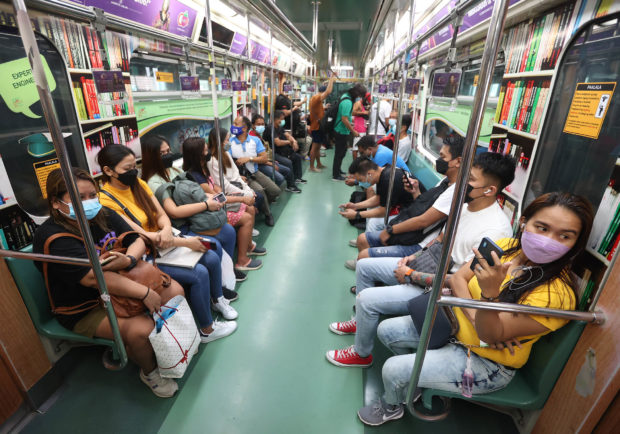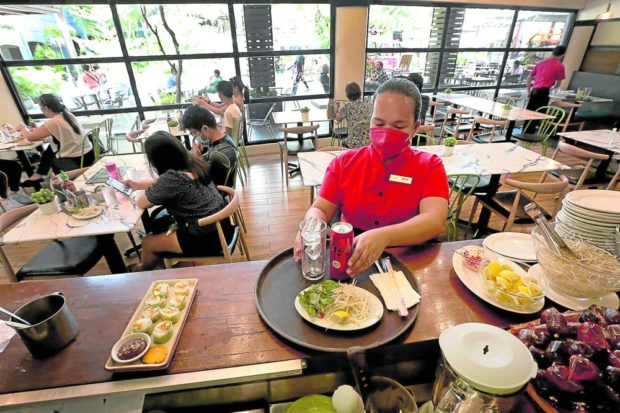Old transport problems test ‘new normal’ shift

GETTING THERE | With mass transport systems back to operating at full capacity, the LRT Line 1 in Manila on Tuesday is slowly seeing the return of its “old normal’’ crowd. No more social distancing here, just face masks providing the only protection against coronavirus transmission. (MARIANNE BERMUDEZ / PHILIPPINE DAILY INQUIRER)
MANILA, Philippines — The pre-pandemic problem of inadequate public transport reemerged on the first day of the new normal, with people cramming trains and buses as though the COVID-19 threat has been completely eliminated.
“Baka pati ’yung guardian angel mo ay sumuko na rin (even your guardian angel would give up),” said Joshua Llego, a 26-year-old junior architect who works in Ortigas, after seeing a big volume of passengers on the platform of the MRT 3 station on Quezon Avenue when he took the train during Day 1 of Alert Level 1 in Metro Manila.
The day before, he observed that the train coming from the North Avenue station had only a few passengers, making it easy for him to get a seat.
One obvious change he saw on Tuesday was that the single line of passengers for each door of the train had doubled.
Llego also noticed that there were fewer marshals, who had the difficult task of maintaining proper distance among train passengers.
“There is this added aggravation of being exhausted apart from the fear of being infected,” Llego said of the “hassle” that he and his colleagues had to endure on the way to work.
“What I can see is that we are returning to the old normal. For me, this ‘new normal’ concept is actually a return to the old ways based on my experience in [public] transport and the protocols,” Llego stressed. “[What] I observed [is] that we are forgetting what we should have learned from two years of the pandemic.”
On midmorning of Tuesday, a bus in Barangay Greater Lagro plying from San Jose del Monte in Bulacan to Quezon Avenue had nearly all its seats occupied.
Passengers seem to have started to go back to the old practices inside the bus: some have fallen asleep, one passenger secretly eating despite a rule prohibiting it, and another heard coughing, although everyone was wearing a face mask.
Plastic dividers used to maintain physical distancing inside the bus were now rolled up since capacity inside all modes of public transportation is 100 percent under Alert Level 1.
A group of transport advocates also noticed Llego’s observation, pointing out that transportation needed for the return of workers under alert level 1 has been “severely underestimated.”
Call for caution
“We raised the alarm of a crisis in mobility since 2018 but there has been a lack of urgency to fully act on recommendations that will allow our roads to serve the average commuter who takes public transportation, bikes, or walks,” AltMobility PH director Ira Cruz said.
During a meeting with President Duterte and other Cabinet officials in Malacañang on Monday night, the country’s vaccine czar, Secretary Carlito Galvez Jr., cautioned that there was still a need to “observe well” the implementation of Alert Level 1 every week while the government continued with its aggressive vaccination drive.
‘Historic event’
Galvez described the transition to alert level 1 as a “historic event” considering that it took place just a year after the government started its vaccination rollout.
“However, we still need to be vigilant and to guide the people, our local government units, and all institutions to self-regulate and manage, and live with the virus,” the secretary said.
“We need to remain focused on improving [vaccination coverage by] providing boosters, providing protection to our children and seniors, and achieving a resilient ‘wall of protection,’” he said, adding that around three million seniors and an equal number of children age 12 to 17 are still unvaccinated, while only 10 million Filipinos have received their booster shot since October last year.

FULL SERVICE | Behind the mask, this waitress working at Eastwood commercial center in Libis, Quezon City, has a reason to smile. Restaurants may now serve diners at full capacity, and those see-through plastic barriers on tables are finally gone. (GRIG C. MONTEGRANDE / PHILIPPINE DAILY INQUIRER)
The government’s economic officials, on the other hand, are more optimistic about recovery with the shift to Alert Level 1.
Socioeconomic Planning Secretary Karl Kendrick Chua said on Tuesday that 62 percent of the country’s economy, covering 20.3 million workers or about 48 percent of the country’s workforce, would start recovering under the new normal.
He added that P9.4 billion worth of economic activity would be generated a week in areas under Alert Level 1, translating to P3 billion in more salaries weekly.
Full on-site work in gov’t
Trade Secretary Ramon Lopez, for his part, said there would be more spending because “when people are going out, there will be more things to spend for on their way to work or home.”
Government agencies are also required to comply with the 100-percent on-site workforce deployment in accordance with a memorandum circular issued by Executive Secretary Salvador Medialdea on Monday.
Work-from-home arrangements may be required for workers who get sick, their close contacts, or asymptomatic workers who are waiting for the result of their COVID-19 test or completing the prescribed quarantine period.
At the televised Laging Handa public briefing, Civil Service Commission member Aileen Lizada said government agencies must check and ensure that workplaces and personnel are safe and health protocols are enforced at all times.
She also advised government agencies to get their Safety Seal from the Department of the Interior and Local Government to demonstrate that their worksites complied with the minimum public health standards and occupational safety and health regulations.
RELATED STORY
For more news about the novel coronavirus click here.
What you need to know about Coronavirus.
For more information on COVID-19, call the DOH Hotline: (02) 86517800 local 1149/1150.
The Inquirer Foundation supports our healthcare frontliners and is still accepting cash donations to be deposited at Banco de Oro (BDO) current account #007960018860 or donate through PayMaya using this link.